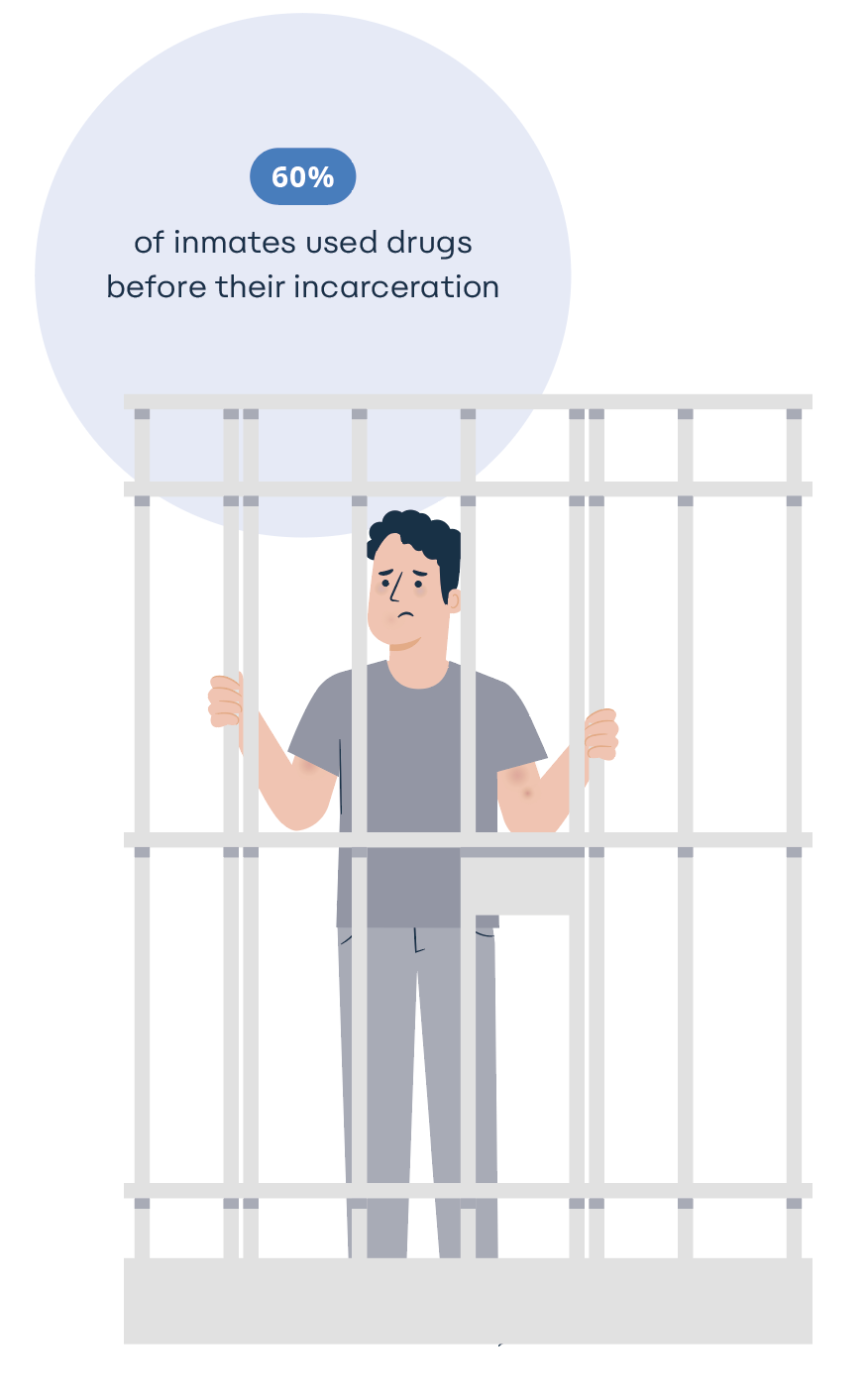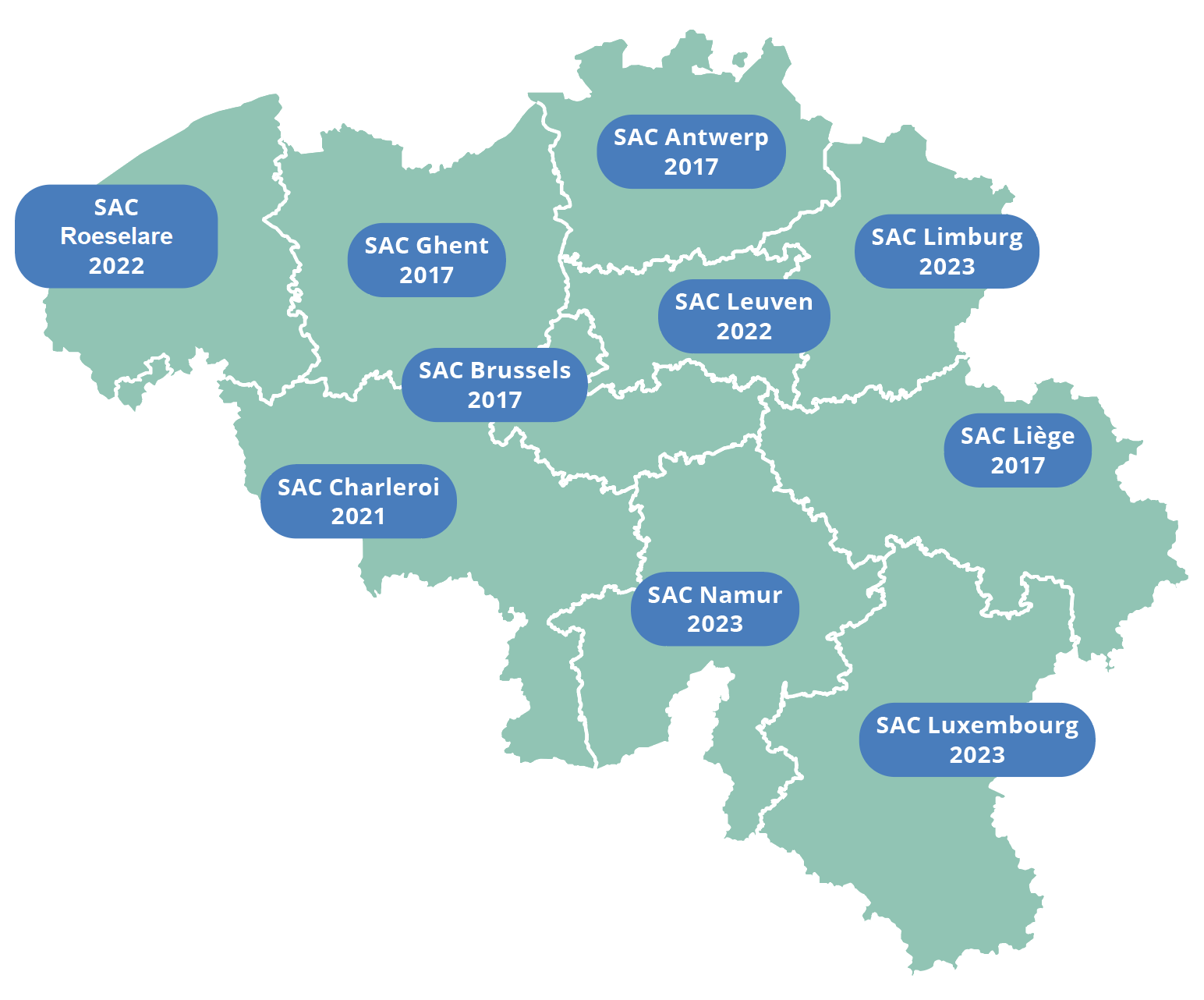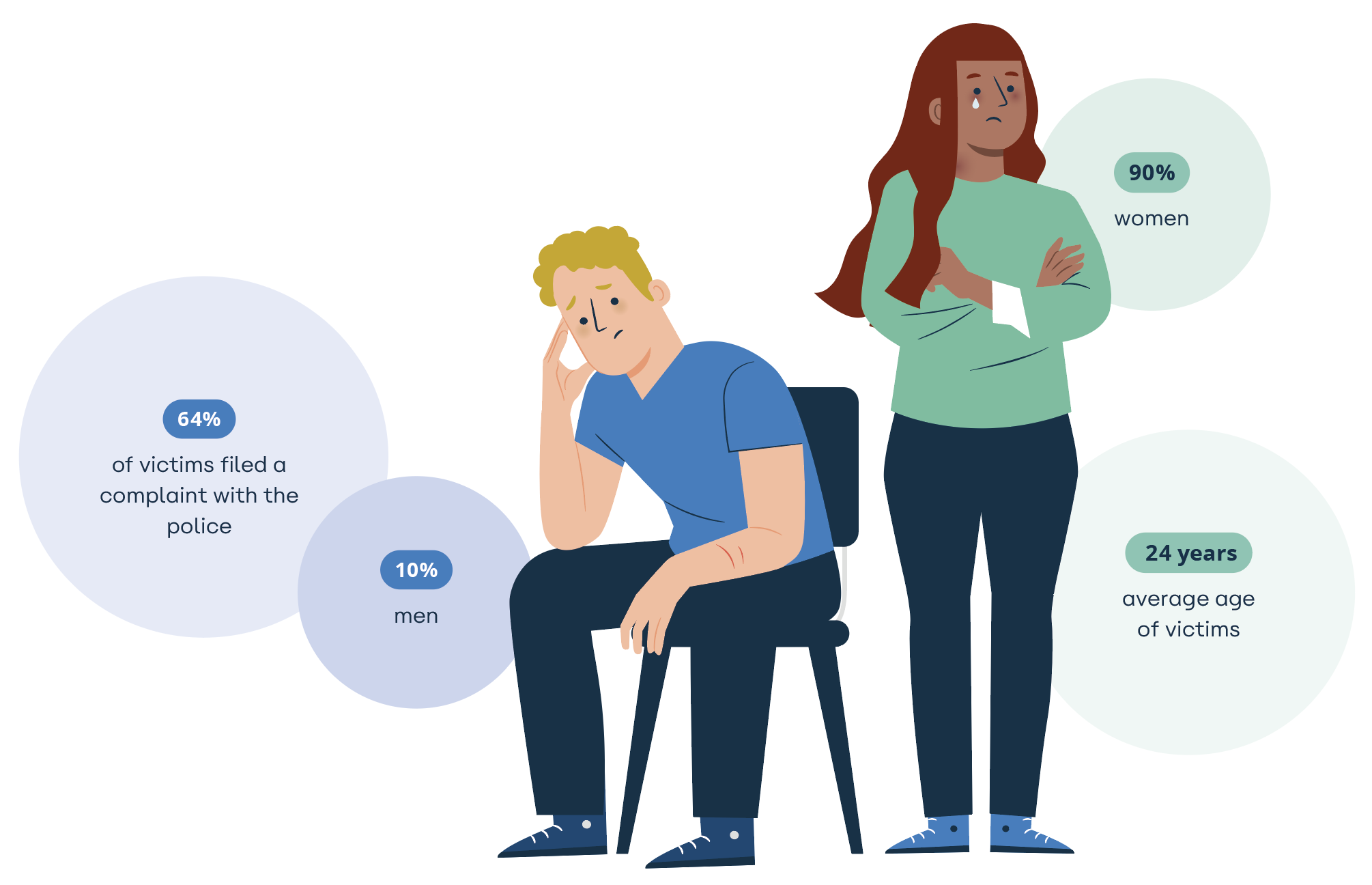- Details
The use of drugs and alcohol in Belgium
The use of psychoactive substances and addiction problems are a public health issue, since the use of these substances poses a risk to the individual health of the user, among other things. Affected individuals must be able to access quality care services without being stigmatised or facing discrimination. To address these issues, the federal government has initiated several projects in various sectors:
- Care model for drug-using prisoners
- Tackling inappropriate use of psychopharmaceuticals
- Addressing substance abuse in hospitals
- Raising awareness among healthcare professionals
Below we take a closer look at some of these projects. The goal of these projects is to counter the problems caused by drug use and promote the health and well-being of individuals. Through collaboration with various agencies and professionals, these projects strive to provide early identification and intervention, treatment, reintegration and social support for those facing drug-related problems. Through concerted efforts, the government seeks to reduce the harmful effects of drug use and promote a safer and healthier society.
 |
Care model for drug-using prisoners Despite the daily efforts of care providers and the intense efforts of the FPS Justice, drug and medication use in Belgian prisons remains high. Drug use entails various health risks and can place significant pressure on prison security. A Belgian study[1] found that almost 60% of inmates used drugs before their incarceration, which is higher than the international average of 50%.[2]. As part of the penitentiary healthcare reform, the FPS Public Health, in collaboration with the FPS Justice, funded an adapted care model for incarcerated drug users through a pilot project in three prisons in 2017:
|
Three non-profit organisations specialising in providing assistance to drug users are receiving funding to provide additional training, expertise and staffing support to the three prisons.
In each of these prisons, additional care staff have been recruited and the existing care and prison staff have received additional training, so that prisoners with a drug problem can be given more personalised support. Furthermore, inmates are now systematically screened for drug use upon arrival, so that they can be guided to the right help more quickly if necessary. The relevant care workers inside and outside the prison walls are also in close contact with each other, which helps to ensure the continuity of care.
- In Belgium’s largest prison, Lantin, no fewer than 1,447 inmates were screened over a 12-month period, of whom 50.2% reported using drugs and 12.8% of these drug users were included in the pilot project.
- Hasselt is a smaller and more modern prison with a special drug-free ward where inmates who choose to stop using drugs can be admitted. In this prison, 303 inmates were screened and 184 (60.7%) of them reported using drugs from which 46.2% opted to participate in the project.
- We have similar data for Saint-Gilles, where 43.6% of those screened were found to use drugs and 109 inmates were followed for 12 months in the project. Inmates in Saint-Gilles are currently being transferred to Haren prison.
Percentage of drug users compared with number screened persons
|
|
In total, this pilot project has already screened thousands of inmates and offered around 1,500 care pathways. In addition to its original tasks, the project will now focus on post-detention aftercare, the involvement of front-line psychologists and peer support. In March 2023, the FPS Health launched a call to expand the pilot project to seven other prisons. The project will again be monitored by a group of scientific experts and an 18-month training course will be provided to support the prisons. This takes place on the initiative of the NIHDI.
Tackling inappropriate use of psychopharmaceuticals
Belgium continues to have the largest population of users of psychopharmaceuticals. Psychopharmaceuticals are drugs used in the treatment of psychiatric disorders and psychological problems. These drugs can be classified into several groups: antipsychotics, antidepressants, narcotics and sedatives, and stimulants such as Rilatine.
 |
In 2022, it was estimated that more than 3 million Belgians were taking at least one psychopharmaceutical. This is 1 belgian out of 4. Narcotics and sedatives are the most commonly used[3]. |
Psychotropic treatments are not always adapted to patients’ needs, are often unjustifiably prolonged, poorly monitored and rarely questioned. Psychotropic drugs may be necessary in some cases, but only at the right dose and for the right length of time. If possible, chronic use should be avoided, to prevent unnecessary side effects and, in the case of certain types of psychotropic drugs, dependence or addiction. It’s also crucial to stop taking them gradually if their value is no longer proven.
The Belgian Psychotropics Experts Platform (BELPEP) aims to promote the appropriate use of psychopharmaceuticals such as antidepressants, narcotics and sedatives in Belgium. This includes proper prescribing and follow-up of treatment. We note that some patients are prescribed psychopharmaceuticals when there may be non-drug alternatives, while others are not prescribed a psychopharmaceutical when one might be essential for optimal treatment of their condition.
More information about BELPEP: https://www.health.belgium.be/fr/sante/organisation-des-soins-de-sante/qualite-des-soins/bonnes-pratiques/belgian-psychotropics
An awareness campaign was launched by the FPS Public Health in September 2023, targeting general practitioners, pharmacists and psychologists. The goal of this campaign is to draw attention to the proper use of psychopharmaceuticals, where open dialogue with patients and information sharing among healthcare professionals are essential. Attention is being drawn again to resources such as clinical guidelines, training courses and an online handbook to facilitate this dialogue.
More information: https://www.usagepsychotropes.be
Alcohol care pathway in general hospitals
Alcohol consumption poses risks to both the physical and psychosocial health of users. It can cause various diseases as well as accidents. According to Sciensano’s Health Survey in 2018, alcohol consumption is a potential hazard for 14% of the Belgian population[4].
It is recommended to limit alcohol consumption to no more than 10 standard units per week (1 standard glass = 1 unit = 10 grams of pure alcohol) and not to consume alcohol daily. It is estimated that about 20% of all patients admitted to general hospitals exhibit harmful or risky alcohol use.
In 2009, the pilot project ‘Tools & alcohol care pathway’ was launched in general hospitals on the basis of the observation that alcohol-related problems were still under-recognised in general hospitals. The goal of this project is to improve the detection and treatment of people with alcohol-related problems through training and awareness of healthcare personnel and by developing an alcohol care pathway that strengthens collaboration.
 |
The benefits for the hospitals where the project has been implemented are numerous. Healthcare providers are paying more attention to alcohol use in their daily practice, thanks in part to many resources such as brochures, guidelines, posters, care pathways, abstinence scales, and so on. Patients are referred more quickly and treatment of alcohol-related withdrawal symptoms is more effective. On the basis of the positive results, the project has been expanded to 15 general hospitals. |
[1]Favril, L., & Laenen, F. V. (2018). Predictors of drug use during detention: data from 1,326 inmates from 15 prisons in Flanders. PANOPTICON, 39(4), 296–312. https://biblio.ugent.be/publication/8577366
[2]Mundt, A. P., Baranyi, G., Gabrysch, C., & Fazel, S. (2018). Substance use during imprisonment in Low- and Middle-Income countries. Epidemiologic Reviews, 40(1), 70–81. https://doi.org/10.1093/epirev/mxx016.
[3]Source: IQVIA Belgium Le Marché Pharmaceutique Belge- National Sell In Audit for the period 2018-2023; and Regional Sell Out Patient data for the period 2022
[4]L. Gisle, S. Demarest, S. Drieskens. Health Survey 2018: Alcohol use. Brussels: Sciensano. Accessed on 1 October 2023, from www.gezondheidsenquete.be
- Details
|
Findings Results from the sixth COVID-19 Health Survey in April 2021 indicated that 11% of the adult population shows signs of an eating disorder (up from 8% in 2013 and 7% in 2018)[1]. These signs are most common in the 18 to 29 age group and more common among women (13%) than men (9%).
|
Evolution of the percentage of individuals aged 18 and older showing signs of an eating disorder
|
Evolution in number of hospital stays in psychiatric and general hospitals due to eating disorders
|
More than 40,000 hospital stays related to an eating disorder are recorded annually in general and psychiatric hospitals[2]. Eating disorders are associated with a heavy disease burden, have a strong impact on all life domains, and are associated with suicide risk. One third of deaths among persons with eating disorders are due to suicide. At the same time, we can see that the care offered to young people with an eating disorder varies greatly from place to place and that care programmes that have been started are sometimes interrupted because specific follow-up care is not or hardly available near the living and learning environment of young people. |
New policy initiatives
 |
The Interministerial Conference on Public Health (IMC) agreed on December 14 2022, to develop a transversal care model of eating disorders as an example of integrated care. This model is based on the specific proposals of the Committee on the New Mental Health Policy for Children and Youth (COMMHCY). It clearly states that there is a need in Belgium for a population-orientated care organisation.
|
Such care organisation leads to more health gains, greater well-being, less suffering and lower social costs.
To achieve this objective, a care pathway will be developed for children and adolescents with eating disorders. As a complement to the initiatives within the states, this involves:
- Training of primary care providers around eating disorders so that they learn to recognise signs of an eating disorder, dare to intervene or to enable them to refer.
- Further development of specialised psychological and dietetic care for adolescents with eating disorders, preferably as part of a multidisciplinary collaboration with general practitioners, psychologists and psychiatrists. Cooperation and consultation will be actively encouraged in this regard.
- Support for outpatient care with expertise through multidisciplinary outpatient support teams, known as MAST teams. Their job will be to support outpatient providers so that young people can be supervised and treated in their own environment for as long as possible. If needed, they can provide specific training and peer supervision to assistance providers. In difficult pathways, they will be responsible for care coordination and may also take steps to address gaps in care provision in terms of policy, as well as helping to look for solutions within the framework of the mental health networks.
- Increasing the flexibility of intensive offerings and having more options and variations of assistance forms developed to provide better tailored care. This mainly involves various forms of part-time treatment and (intensive) multi-family therapy (MFT and iMFT)
The new care pathways for children and adolescents with eating disorders will be implemented from 2024.
[1]Sixth COVID-19 Health Survey. First results (2021). Brussels: Sciensano. Filing number/2021/14,440/29. Accessed 1 October 2023, from https://doi.org/10.25608/r4f5-1365
[2]IIn 2020, we saw a decrease because of COVID-19 pandemic measures and because of the temporary suspension of registration of diagnoses in Minimal Psychiatric Data (MPD).
- Details
In Belgium , official police statistics show that around 11 rapes per day were reported to police in 2021. However, according to the 2018 Security Monitor, around 82% of sexual assaults and rapes go unreported and are therefore not included in police and Justice statistics. The most recent prevalence survey in Belgium in 2021 shows that 16% of women and 5% of men have been victims of rape in their lifetime[1] This violence has a significant impact on victims’ mental, sexual and physical health and requires integrated medical, medico-legal and legal care.
Sexual Assault Centres were established in Belgium to provide a response and assistance to victims of sexual violence and to implement Article 25 of the Istanbul Convention. In late 2017, three Sexual Assault Centres were opened in the judicial districts of Brussels, Liège and East Flanders. In 2021, two new centres were opened: one in Antwerp and one in Charleroi. Centres in West Flanders and Leuven opened in 2022 and in 2023 centres opened in Namur, in Luxembourg and Limburg. Located in a hospital, these SSG are funded by the Institute for Gender Equality and by the FPS Public Health.

Each SAC welcomes victims 7 days a week and 24/7 and has forensic nurses, a psychologist, a doctor, a coordinator and an administrative assistant.
The centre works with police vice inspectors, who have a room at the SAC to file reports. The SAC also works with prosecutors to follow up on reports[2] .

More information: https://cpvs.belgium.be/fr
Some figures[3] :
3,287 reports
by sexual assault victims in 2022

Evolution in number of reports of victims of sexual violence
[1]Keygnaert I., et al. (2021). UN-MENAMAIS: Een beter begrip van de Mechanismes, Aard, Omvang en Impact van Seksueel Geweld in België. Gent: UGent. Geraadpleegd op 1 oktober 2023, van https://www.ugent.be/nl/actueel/bijlagen/seksueel-geweld-belgie-aanbevelingen-1
[2] Zorgcentra seksueel geweld: het model ZSG [Sexual Assault Centres: the SAC model] (2021 edition). Brussels: Institute for the equality of women and men. Accessed on 1 October 2023, from https://zsg.belgium.be/nl
[3]Fomenko E., Baert S. & Keynaert I. (2022). Zorgcentra seksueel geweld in België: Evolutief rapport 2021 [Sexual Assault Centres in Belgium: Progress report 2021]. Ghent University- ICRH. Accessed on 1 October 2023 at https://www.icrhb.org/nl/publicaties/8755724
- Details
What is intercultural mediation?
Intercultural mediation is a set of activities to minimise the effects of language barriers, socio-cultural differences and tensions between ethnic groups within healthcare settings. The goal is to offer equal access and quality of care for all patients regardless of their migrant background. Intercultural mediators act as interpreters, clarify misunderstandings, offer explanations of cultural differences and assist both care providers and patients during the care process. In exceptional cases, such as in cases of racism or discrimination, they act as patient advocates. Currently, 113 intercultural mediators are active.
On-site intercultural mediation takes place in 40 general and 8 psychiatric hospitals, as well as in a network of 28 community health centres.
Intercultural mediation via videoconferencing
In addition to on-site intercultural mediation, an offering of intercultural mediation via videoconference was created. This uses an app developed for this purpose and care providers can use the app to reserve a mediator for an intervention via video. Twelve languages are continuously available, including Turkish, Russian and several variants of Arabic. Recently, Ukrainian and languages from Afghanistan (Dari, Pashto, Urdu) were made available. Healthcare providers can also request interventions in less commonly requested languages such as Italian and Bosnian-Serbian-Croatian.
Assistance providers are increasingly using intercultural mediation via video. Currently, more than 250 healthcare facilities use this service. The total number of interventions via video more than doubled from 8,178 to 17,511 from 2020 to 2022.
Evolution in number of video conferences for intercultural mediation
The majority of these videoconferences, around 56%, take place in hospitals. The offer of intercultural mediation via videoconference is now available to general and psychiatric hospitals, general practices, community health centres, medical services of reception structures for asylum seekers and front-line psychologists.
Number of interventions per type of institution
Intercultural mediation in the mental health sector
Intercultural mediation is also used in mental health services, although it is still relatively limited. In 2022, 327 video interventions were conducted in 8 psychiatric facilities. Mental healthcare providers stress that intercultural mediation makes it possible to provide better care to people who were previously hard to reach. Taking into account the higher incidence of mental health problems among people of migrant background, this is an important development. This is all the more true since, as a result of a series of geopolitical crises (Syria, Afghanistan, Ukraine), we have experienced and are experiencing a significant influx of potentially traumatised asylum seekers.
More information Guide for Intercultural Mediation in Health Care
More information What are the roles of intercultural mediators in health care?

